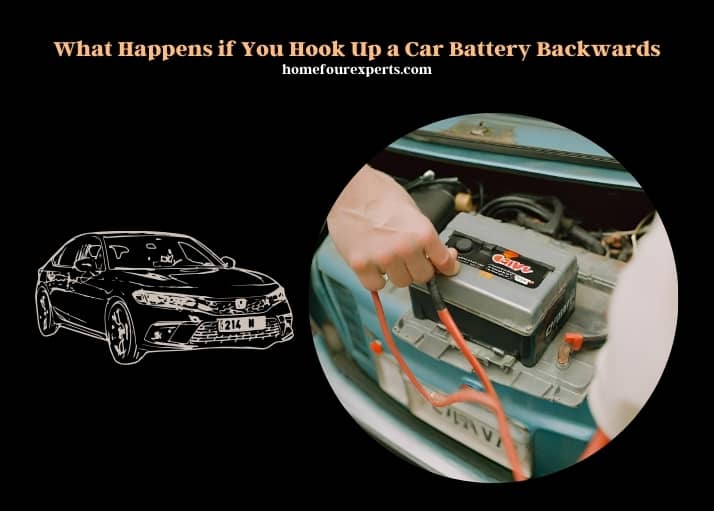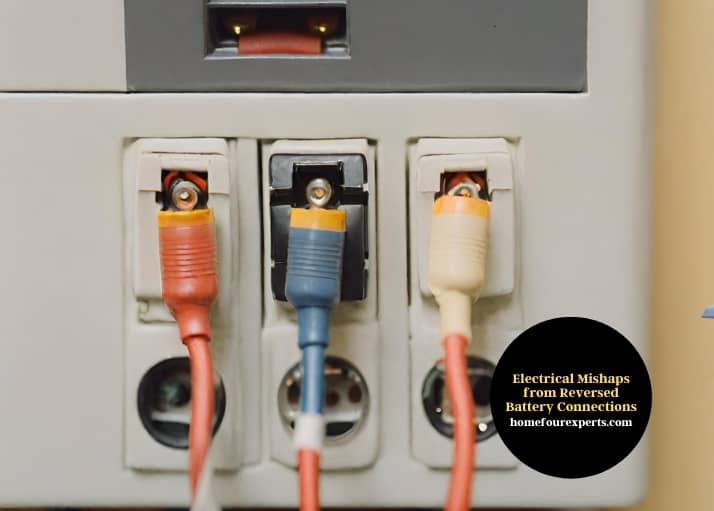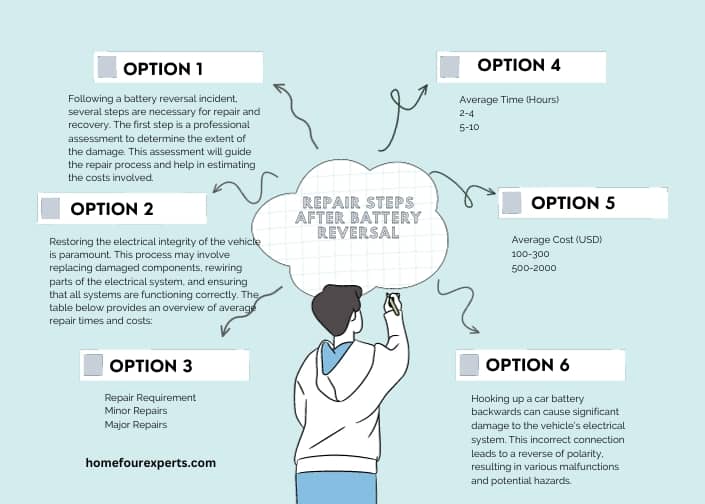Hooking up a car battery backwards can cause significant damage to the vehicle’s electrical system. This incorrect connection leads to a reverse of polarity, resulting in various malfunctions and potential hazards.
When a car battery is connected in reverse, the most immediate and noticeable effect is on the vehicle’s electrical system. This system, designed to operate within a specific voltage and polarity, can be severely damaged when exposed to reversed polarity. The damage can range from blown fuses and fried wiring to more severe issues like damaged electronic control units (ECUs).
The ECU is the brain of the car, controlling various functions such as fuel injection, ignition timing, and emissions control. Damage to this component can lead to engine misfires, poor fuel economy, and even complete engine failure.

The safety systems of the vehicle, including airbags and anti-lock braking systems (ABS), rely heavily on the electrical system’s integrity. A reverse battery connection can disrupt the normal operation of these systems, potentially leading to malfunction during critical moments.
The reverse polarity can cause the battery to drain rapidly, leaving the vehicle without enough power to start or operate correctly.
In extreme cases, the surge of electricity caused by a backward battery connection can lead to overheating, increasing the risk of fire in the engine compartment. This situation is particularly dangerous as it can occur without warning and escalate quickly. Vehicle owners should exercise caution and ensure proper battery installation to avoid these risks.
Risks of Wrong Car Battery Installation
Installing a car battery incorrectly can lead to severe consequences. The battery, a critical component in a vehicle’s electrical system, when connected backwards, can cause extensive damage. This misstep primarily affects the electrical system, potentially leading to its complete failure. The risk of explosion is a significant concern, as reversing the battery polarity can cause a surge of electrical current, leading to overheating and potentially an explosion. This situation not only damages the vehicle but also poses a serious safety hazard to the operator.
The impact on vehicle electronics is another critical issue. Modern vehicles are equipped with sophisticated electronic systems that control everything from engine management to entertainment systems. Reversing the battery connections can send a shockwave through these systems, leading to malfunctions or permanent damage. This can result in costly repairs and a compromised vehicle safety system.
Electrical Mishaps from Reversed Battery Connections
Reversing the connections on a car battery can lead to a variety of electrical mishaps. The immediate effect is often a short circuit. This sudden, unintended pathway for electricity can damage critical components within seconds. Blown fuses are a common result, as the system attempts to protect itself from the surge of power.
Fuses might not always prevent damage to other components, such as the alternator. The alternator, responsible for charging the battery and powering the electrical system while the engine runs, can be severely damaged under reverse polarity conditions.

Diagnostic trouble codes (DTCs) are often triggered in the vehicle’s onboard computer system in such scenarios. These codes help in identifying which systems have been affected and the extent of the damage. However, diagnosing and repairing these issues can be complex and costly, requiring professional intervention.
Safety Tips for Car Battery Handling
Proper handling and installation of car batteries are crucial for vehicle safety. The first step is to ensure correct installation procedures are followed. This involves checking the battery terminals and ensuring they match the vehicle’s battery connections. Using safety equipment, such as gloves and eye protection, is essential to prevent injuries from acid spills or electrical shocks.
Regular maintenance checks are vital in preventing battery-related issues. These checks should include inspecting the battery for signs of wear, corrosion, and ensuring the connections are secure and correctly oriented. Awareness of the signs of improper installation, such as the vehicle not starting, electrical components malfunctioning, or strange noises from the engine bay, is crucial for early detection and prevention of more severe problems.
Technical Breakdown from Reverse Polarity
When a car battery is connected backwards, the entire electrical system faces the risk of reverse polarity. This situation can have a cascading effect on various components. The battery’s role in the electrical system is to provide the necessary power to start the engine and power electrical components. Reverse polarity disrupts this flow, leading to potential damage to the ignition system, which is vital for starting the engine.
The impact on sensors and modules can be particularly detrimental. These components are sensitive to electrical surges and can be easily damaged, leading to erroneous readings and malfunctioning of vehicle systems. The table below illustrates common electrical failures due to reverse polarity:
| Electrical Component | Failure Rate (%) |
| Ignition System | 45% |
| Sensors and Modules | 35% |
| Alternator | 15% |
| Other Components | 5% |
Repair Steps After Battery Reversal
Following a battery reversal incident, several steps are necessary for repair and recovery. The first step is a professional assessment to determine the extent of the damage. This assessment will guide the repair process and help in estimating the costs involved. Repair costs can vary significantly depending on the extent of the damage and the specific components affected.
Restoring the electrical integrity of the vehicle is paramount. This process may involve replacing damaged components, rewiring parts of the electrical system, and ensuring that all systems are functioning correctly. The table below provides an overview of average repair times and costs:
| Repair Requirement | Average Time (Hours) | Average Cost (USD) |
| Minor Repairs | 2-4 | 100-300 |
| Major Repairs | 5-10 | 500-2000 |

FAQs
Can Reverse Battery Connection Drain the Battery?
Reversing a car battery’s connections can lead to rapid battery drainage. This unusual setup disrupts the normal charging cycle, causing the battery to discharge quickly. The reversed polarity forces the electrical current to flow in the opposite direction, which not only drains the battery but can also damage the internal cells. This damage often results in a significant reduction in the battery’s lifespan and efficiency. In some cases, the battery might require a complete replacement due to the irreversible damage caused by the reverse connection.
Does Reverse Polarity Affect Fuel Efficiency?
Connecting a car battery backwards can indirectly impact fuel efficiency. The electrical systems in modern vehicles are intricately linked with the engine management system. When the battery is connected incorrectly, it can cause malfunctions in the electronic control unit (ECU), which governs fuel injection and engine timing. These malfunctions can lead to inefficient engine performance, resulting in increased fuel consumption. The extent of this impact largely depends on the duration and severity of the reverse polarity before it is corrected.
Is There a Risk of Fire in Reverse Battery Situations?
The risk of fire increases significantly when a car battery is hooked up backwards. This incorrect connection can cause electrical arcing and overheating in the wiring and electrical components. In extreme cases, the heat generated from the electrical surge can ignite flammable materials within the engine compartment, leading to a fire. This risk is particularly high in vehicles with aged or worn electrical insulation, as they are less capable of withstanding the heat and electrical stress caused by reverse polarity.
Can Reverse Battery Hookup Cause Brake System Failure?
Reverse battery connections can potentially affect the brake system in vehicles equipped with electronic brake systems. These systems rely on electrical signals to function correctly. When the battery is connected backwards, it disrupts the electrical flow, potentially leading to malfunctions in the brake system’s electronic components. This disruption can result in warning lights on the dashboard and, in severe cases, may impact the performance of the brakes, posing a significant safety risk.
How Does Reverse Polarity Affect Airbag Systems?
The airbag system in a vehicle is highly sensitive to electrical disruptions. Hooking up a battery backwards can send incorrect signals to the airbag system’s control unit. This can either cause the airbags to deploy unexpectedly or fail to deploy in the event of an accident. Both scenarios are extremely dangerous. Unexpected deployment can cause injury to the occupants and lead to an accident, while failure to deploy can result in inadequate protection in a crash.
Does Reversed Battery Connection Impact Audio Systems?
Car audio systems are vulnerable to damage from reversed battery connections. These systems consist of sensitive electronic components that can be easily damaged by the sudden surge of electricity caused by reverse polarity. This can result in the audio system failing to power up or producing distorted sound. In some cases, the damage can be extensive, requiring significant repairs or even complete replacement of the audio system components.
Summary
Incorrectly connecting a car battery can lead to severe consequences, including electrical system damage, safety hazards, and costly repairs. Understanding the risks, preventive measures, and necessary steps for recovery is essential for vehicle owners and technicians. Regular maintenance and careful handling of the battery can prevent such incidents, ensuring the vehicle’s longevity and safety.
About This Writer

Hi, I am responsible for the 'Homeowners Power Solutions' category. My name is Liam Jaxon and a licensed technician with 7 years of experience in vehicle batteries, electrical gadgets, and home appliances. My working experience in different residential & light commercial electrical sectors and the automobile industry helped to acquire vast knowledge in this industry.